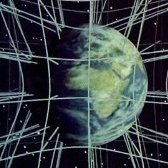Leaderboard
Popular Content
Showing content with the highest reputation on 09/04/20 in all areas
-
You can publicly express support for any theory you want. But others can publicly express their displeasure, and ridicule you for it. Free speech is for all. Even on this forum, you are allowed to present alternate theories of human evolution. But you had better do it in good faith, and back it with evidence.2 points
-
The reddening we see with the setting Sun is due to the blue end of the spectrum being scattered. Thus the light coming from the direction of the Sun has less Blue light and looks redder. The red-shft we see from distant galaxies cannot be due to a like effect. We measure red-shift by looking at the light's spectrum. In it are patterns of lines that are like "fingerprints" for elements. Each pattern isn't only unique, but it is produced in a certain point of the spectrum. If the red-shift was due to a scattering out of blue light, all you would see would be a dimming in the blue end of the spectrum. The spectral lines would still be there and in the same place. This is not what we see. Instead we see a shift of the whole spectrum towards the red. Spectral lines have moved further to the red end of the spectrum. The wavelength of the light itself has been changed, rather than just certain frequencies filtered out leaving redder light behind. (in fact, red-shifting will shift non-visible frequency ultraviolet into the visible light range.)2 points
-
No, not as far as I know. You have high-energy photons creating particle-antiparticle pairs, so there would be matter around for the photons to interact with. "Photon's past" from whose perspective? Surely not the photon's — no valid frame of reference there. Massive particles were created by photons (the pair production mentioned above) and photons could scatter off of those massive particles. The CMB is consistent with the photon creation from the recombination era - when the universe became transparent, tells us that photons were scattering before that. Is there a photon out there that never scattered? Possibly. I don't know how to assess how unlikely that is, or if it could be detected if nothing happened to send it in our direction.1 point
-
The issue that never seems to get properly defined is what one means by freedom of speech. Case 1: where one is referring to a document such as a country's Constitution (or similar document), then it's a right that the people have to not have the government retaliate or otherwise interfere with speech. But other people mean it as the ability to say whatever they want (case 2), and some go beyond that to mean saying whatever they want without fear of repercussion (case 3) So when one says there is no freedom of speech on this forum, or on some other public forum, that's wrong on terms of case 1. This is not an arm of a government, so there there is freedom of speech in that regard. But such a right is not without limits. If considering case 2 and case 3, then no, there is not. This is a privately-run place, even if the door is (initially) open to all. There are rules (things we won't discuss), and also repercussions for what one says (there may be pushback if someone disagrees with what you say or how you say it)1 point
-
No, the 'alternate reality' is a different interpretation again. The 'cat in the box' is the superposition of states ( of the wavefunction ) in the Copenhagen ( N Bohr ) interpretation.1 point
-
1 point
-
The issue isn't the double-slit experiment. The video merely states that the electron's wave function has two peaks. Explaining the double-slit is getting bogged down in irrelevant (for now) detail, IMO. A wave function that has two sharp peaks basically describes a situation where the electron, if detected, will be found in one of two locations. In this case, the probability is equal, as the wave function has the same amplitude. However, it is not wrong to say that the electron is at both locations before detection. There are experiments other than the double-slit where you have superposition of locations (Kasevich did this with launched atoms into a superposition of states, where the two states would have a physical separation) and the result is not consistent with atoms at one location or the other. (see also: entanglement) The experiments that show this are typically interference experiments, because that's where the results manifest themselves - classical physics can't account for the results. So, both states are occupied before detection. But detection is in one state or the other. How this happens is a matter of what physics interpretation is discussed - that's what was meant by "physicists don't know how this happens." One interpretation is that the wave function "collapses" as a result of the measurement, but that's just a way of understanding the result, not a description of some physical process.1 point
-
I don't think Stephen Hawking was ever a reliable source on how long humanity has left on Earth, no matter his brilliance with respect to black holes and cosmology. I think the reality of moving to space is not anywhere even close to being a viable option - and without a healthy wealthy Earth economy, not likely to ever be one. Failing to go all out to fix our problems here will ensure failure to establish a reliable, colonial foothold in space; space colonisation is not an alternative to Earth, it depends absolutely on Earth. If it achieves true self sufficiency, that will be an emergent outcome of success as an enduring part of Earth's greater economy. What I think with respect to our looming doom is we face the prospect of our civilisation - such as it is - failing us in the face of cumulative problems. Good governance looks thin on the ground to me - and large elements fiercely resists deep, long running foresight and planning. Any collapse of what we see as civilisation won't be the end of humanity by any means, but it likely will put all grand space dreams on hold and make getting back to the wealth and prosperity we now enjoy much harder in any distant future - and what we have is IMO probably unsustainable and overly a product of and dependent on resource over-exploitation in the present at the cost of future resource availability. I am not sure that unrealistic optimism about space and abundant space resources helps with keeping our eyes on this road, hands on this wheel. I am not optimistic either way - because I think it wasn't planning and foresight that got us the civilisation we have here on Earth but for getting space colonies on a sustainable footing the minimum population and economy and infrastructure needs to be very large to be able to reach reliable self sufficiency; self sufficiency in space will be very hard to achieve without those natural ecosystems to do so much stuff we depend and thrive on for free. I don't think space - even being more optimistic even than most optimists - will ever offer mass migration opportunities; mostly the idea seems to be a smallish number get to colonise space, to go on (we hope) to survive and thrive there and Earth's population gets to survive or not (we hope not) as the case may be. We are suppose to be vicariously comforted by this - enough to not resent paying for it. I remain unconvinced that this "some will survive" motivation can be sufficient to support the scales of construction and investment a viable space colonisation program needs. And we could (real possibility) see significant population decline here on Earth - whether we want it and plan it (still possible, over several generations), or not (possibly catastrophically). Interstellar colonising would be much, much harder than Mars - and I think Mars is still way beyond our capabilities. And Mars would be much harder than Asteroids. And those are still extremely hard. I would probably go for Asteroids and free flying space habitats over planets.1 point
-
Seems a massive ( record breaking 142 Ms ) Black Hole was created from the collision of a 66 Ms and 85 Ms BHs. https://www.theweathernetwork.com/ca/news/article/discovery-of-record-breaking-black-hole-collision-surprises-astronomers ( amazing what you find when you go check tomorrow's weather ) Published today from researchers at UBC. ( that's close to Mordred's stomping grounds ) edit I guess now muruep00 knows how supermassive BHs grow in galactic centers, without the need for negative energy, or time transformations.1 point
-
Thank you for your confidence. I must go tonight, but I will draw some (hopefully helpful) diagrams tomorrow.1 point
-
Physics doesn’t seek to ‘understand the true nature’ of things (that would be more of a philosophical or at best metaphysical endeavour) - it only seeks to make descriptive models of natural phenomena, formulated in the language of mathematics. Spacetime in particular is a descriptive model of the motion of test particles under the influence of gravity, as well as the relationships between clocks and rulers in different reference frames. Oftentimes, having a description of how something works also helps to illuminate why it works that way, but that is not necessarily always the case in physics. There really is nothing wrong with a utilitarian approach, in my opinion - even if it sometimes fails to satisfy our curiosity. I personally think that demanding physics to provide answers that are actually beyond its intended domain of applicability is far more dangerous and problematic.1 point
-
Because any conceivable clock - even an ideal one - must be massive, and therefore it cannot be comoving with a photon. Mathematically speaking, you can't parametrise the length of a photon's world line using proper time (because ds=0); however, that doesn't mean that their world lines don't have a well defined length in spacetime. They do, you just need to use a different affine parameter.1 point
-
One way to approach a difficult problems is to break it down into small steps ie substitute a series of lesser questions in this case. So we have How many ways can something exist ? I suggest a great many. How many ways can nothing exist ? I suggest at most one. So the substutute question becomes Statistically why are we suprised that something exists ?1 point
-
Yes, that's true. The theory has changed since then, but not substantially, and the original motivations are probably introduced better by the original author.1 point
-
For simple to understand and easy to read sources, you can't beat the original. The Inflationary Universe, Alan Guth, 19971 point
-
Good question, but very difficult to answer. Part of the key to that could be related to the observation that Eise has introduced and you so cleverly have caught on to: This sets the stage for the famous question of meta-laws: Were the laws of physics already there before the big bang, or did they appear along with everything else? Answering that or setting the question properly (if we can ever do it) will probably get us closer to trying to answer your question. So far, what we've got is this kind of parametrisation of the problem (the inflationary model). One should also ask what "there" and "then" or "before" really mean, as space-time is supposed to have appeared along with matter. The misleading aspect of the picture that I linked to before is that it seems to suggest an extended background (especially in time). It should be conceived of as something of Planckian dimensions (very, very small). And what about time? I don't know. There are several things about inflation I can't quite wrap my head around. To me, overall, it all looks a little bit contrived to be entirely satisfactory. Another major concern of modern theoretical physics is the emergence of time. The potential energy "down which the vacuum fell" does not live in space-time, but in the inflaton-field configuration space. But physicists that work on inflationary models do use a pre-big-bang time as a background for it. Somehow, you must be able to define a sequence of events. Sorry, my word "sea" was not very fortunate. It would be better described as a Planckian-small bundle of fields, I suppose. Well, there are models, all under the name of "inflationary model" something or other; not to explain, but at least to model what must have happened. Basically you put quantum field theory (this theory of particle-antiparticle formation and annihilation) on the background of a field of potential energy. If you set the curve correctly*, you can model much of what must have happened to give rise to the universe as we know it. Inflationary models seem to be particularly good at explaining the seeds of inhomogeneity that gave rise to clusters and superclusters that today are galaxies and clusters and superclusters of galaxies. I must warn you that some very no-nonsense physicists are not completely happy about inflationary ideas. One notable example is Neil Turok. The best source for learning about these things that I know of is Leonard Susskind's online lectures (Stanford). There's also Lawrence Krauss, that Eise suggested. ------------------------------------ In answer to: It depends a little bit on how familiar you are with differential calculus, vectors, power series, things like that. There are many confusing aspects, I know. I'm leaving many questions unanswered. I'm not sure I've done a good job of making it more understandable. *"Model the curve correctly" means it must look something like this (take a look at the graph): At the bottom down of the curve is where the big bang is supposed to have started. "Previous" to that, there is a very prolonged phase of "slow roll", as it's called.1 point
-
I am not a physicist, but in A Universe from Nothing, Lawrence Krauss says that "Nothingness" is unstable. The "Nothingness" that joigus talks about is the 'emptiest' we can reach in our universe. Nothingness in our universe is a bit like a water surface: it can be in complete rest when simply looking at it, but zooming in, you will see molecules bouncing in each other, some of them escaping the surface, some others (or the same) caught at the surface. So a "Nothingness" still less then absolute vacuum in our universe would be unstable, and could produce the Big Bang. However, somehow the laws of nature should somehow exist, i.e there must be a road from absolute nothingness to our universe.1 point
-
Hi. Welcome. Very old question, but very difficult to answer nonetheless. So I'm going to get hold of some visual aids found on the web. Nothingness is quite easy to picture in your mind. Maybe we get that picture from our hours of sleeping without dreams. I don't know. But, The picture of the closest thing to nothingness that we can build from physics is not a featureless scenario. It's more like this: Or, more diagramatically, like this: A perpetual struggle of opposites annihilating each other. It just isn't just nothing. What it suggests is that what we call "nothing" is more like this ephemeral tug of war between ephemeral somethingnesses (virtual particle-antiparticle pairs). Nothing (in a poetic picture derived from serious physics) is a struggle between opposites in which nobody wins. At some point in the past, somebody won (why that was so is still an enigma; I don't like the word "mystery".) The status of the theory so far is that something like this sea of opposites annihilating each other must have fell downhill some kind of modulating field (inflaton field) 13 point something billion years ago, generating real particles and filling the universe with structure. That's called inflationary model of the universe. I hope that helps, but it's been a long time since Leibniz set that question to nowadays. So the story has become more involved.1 point
-
-1 points








